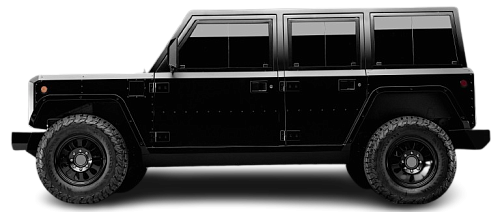Global EV Comparison: BMW i4 M50 vs Bollinger Motors B1 120 kWh
Struggling to Decide? Let AI Help!
Your AI Summary Is Ready!
General Info
Although the Bollinger Motors B1 120 kWh has been announced, it is not yet in production and will not be available for sale in Europe. The BMW i4 M50 (2021-2024) has been discontinued. You can find it for as low as €47700 on the used car market.
The BMW i4 M50 (2021-2024) is a Liftback, whereas the Bollinger Motors B1 120 kWh is a SUV.
| Property | BMW i4 M50 | Bollinger Motors B1 120 kWh |
|---|---|---|
| Years of Production | 2021-2024 | -… |
| Current Status | Discontinued | Announced |
| Country of Manufacture | Germany | USA |
| Body Style | Liftback | SUV |
| Market Availability | EU, USA | USA |
| Price Europe (Used) | €47700 | - Price Europe (Used) |
| GCC Score | 6.5 | 6 |
Range and Efficiency
Even though the Bollinger Motors B1 120 kWh has a larger battery, the BMW i4 M50 (2021-2024) higher energy efficiency results in a longer real-world driving range.
| Property | BMW i4 M50 | Bollinger Motors B1 120 kWh |
|---|---|---|
| Range (EPA) | 435 km | 322 km |
| Range (WLTP) | 519 km | - Range (WLTP) |
| Range (GCC) | 409 km | 274 km |
| Battery Capacity (Nominal) | 83.9 kWh | 120 kWh |
| Battery Capacity (Usable) | 80.7 kWh | 114 kWh |
| Efficiency per 100 km | 19.7 kWh/100 km | 41.6 kWh/100 km |
| Efficiency per kWh | 5.07 km/kWh | 2.4 km/kWh |
| Range and Efficiency Score | 6.3 | 2 |
Charging
Both vehicles utilize a standard 400-volt architecture.
The BMW i4 M50 (2021-2024) offers faster charging speeds at DC stations, reaching up to 207 kW, while the Bollinger Motors B1 120 kWh maxes out at 100 kW.
The Bollinger Motors B1 120 kWh features a more powerful on-board charger, supporting a maximum AC charging power of 19.4 kW, whereas the BMW i4 M50 (2021-2024) is limited to 11 kW.
| Property | BMW i4 M50 | Bollinger Motors B1 120 kWh |
|---|---|---|
| Max Charging Power (AC) | 11 kW | 19.4 kW |
| Max Charging Power (DC) | 207 kW | 100 kW |
| Architecture | 400 V | 400 V |
| Charge Port | CCS Type 2 | CCS Type 1 |
| Charging Score | 6.9 | 7.8 |
Performance
Both vehicles are all-wheel drive.
Although the Bollinger Motors B1 120 kWh has more power, the BMW i4 M50 (2021-2024) achieves a faster 0-100 km/h time.
| Property | BMW i4 M50 | Bollinger Motors B1 120 kWh |
|---|---|---|
| Drive Type | AWD | AWD |
| Motor Type | PMSM (front), PMSM (rear) | PMSM (front), PMSM (rear) |
| Motor Power (kW) | 400 kW | 458 kW |
| Motor Power (hp) | 536 hp | 614 hp |
| Motor Torque | 795 Nm | 905 Nm |
| 0-100 km/h | 3.9 s | 4.7 s |
| Top Speed | 225 km/h | 162 km/h |
| Performance Score | 6.7 | 6.3 |
Dimensions
The Bollinger Motors B1 120 kWh boasts a more extended wheelbase.
| Property | BMW i4 M50 | Bollinger Motors B1 120 kWh |
|---|---|---|
| Length | 4783 mm | 4368 mm |
| Width (with Mirrors) | 2073 mm | 1961 mm |
| Width (w/o Mirrors) | 1852 mm | - Width (w/o Mirrors) |
| Height | 1448 mm | 1847 mm |
| Wheelbase | 2856 mm | 3017 mm |
Cargo and Towing
Neither car is equipped with a frunk (front trunk).
The BMW i4 M50 (2021-2024) has a towing capacity of up to 1600 kg, whereas the Bollinger Motors B1 120 kWh is not officially rated for towing in the EU.
| Property | BMW i4 M50 | Bollinger Motors B1 120 kWh |
|---|---|---|
| Number of Seats | 5 | 5 |
| Curb Weight | 2290 kg | 2268 kg |
| Cargo Volume (Trunk) | 470 l | - Cargo Volume (Trunk) |
| Cargo Volume (Max) | 1290 l | 2294 l |
| Cargo Volume (Frunk) | - Cargo Volume (Frunk) | - Cargo Volume (Frunk) |
| Towing Capacity | 1600 kg | - Towing Capacity |
| Cargo and Towing Score | 5 | 7.1 |




